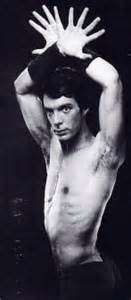GULP! IT WAS THIRTY YEARS AGO TODAY
Posted by Deirdre | Filed under Blog
I joined the Globe and Mail as the newspaper’s last full-time dance critic 30 years ago this month, and I hit the floor running. I wrote two reviews my first day on the job, one on Canada’s now defunct National Tap Dance Comnay, and the other on New York’s Bill Cratty, a glorious dancwer who unfortunately passed away in 1998 at the too young age of 47. My review of his show is quoted on Cratty’s Wikipedia page. I reprint my review in memory of him, and that innocent time of my own professional beginnings writing on what I continue to be passionate about — the art of dance. Happy anniversary to me:
THE BILL CRATTY Dance Theatre, at the Premiere Dance Theatre until Saturday, has neatly carved a new geometry out of the bedrock of post- modern dance. Shunting aside the spiritual significance of so many angst- ridden modern dance companies, Cratty’s New York- based troupe lauds the physical with works that generally are vigorously athletic.
Formerly a soloist with the Jose Limon Dance Company for eight years, Cratty brings to his own company (founded in 1981) a wealth of experience. All three works on this program demonstrate some indebtedness to a number of this century’s great choreographers.
But it takes a discerning eye to pick out the traditional dance vocabulary of, say, Doris Humphrey or Kurt Joos. For Cratty does well to camouflage their influences in his work with his own even coloring.
In the choreographer’s quest for novelty, Cratty has succeeded by creating bold, new images. His distinctive style is forged from a love of the pure, kinetic drive of dance combined with an enthusiasm for gymnastics. The result is movement that’s free-spirited and taut, whimsical and entertaining.
Promenades, the first work on the program, is a paean to the body electric. With his tongue firmly in cheek, Cratty has crafted a four- part variation on the theme of promenade as social ceremony. Each section derives its personality from the accompanying music. But what is interesting is the way the choreography works contrapuntally to the music instead of with it so as to open new avenues for exploration and discovery. For instance, the first section features music by Haydn. But rather than presenting dancers in elegant, eighteenth-century garb, Cratty parades them in scanty garments designed by Don Mangone so as to stress the earthiness at the core. The music is further parodied by the dancers, Jane Carrington and Michael Kraus, who exaggerate its perfect symmetry by walking in sharp, linear formation across the stage. When the couple discover sexuality, however, the strict formal order breaks down as bodies grab, swing and lock together. Carnality never looked so glorious.
While the story is as old as Adam and Eve and is, therefore, somewhat predictable, Cratty still manages to charge it with some lively touches. At one point, the man’s body models itself into a bed on which the woman lies. With his legs and feet, he gently moves her body, strengthening the intimacy between them with a rocking motion which soothes beyond the background music.
The final section of Promenades is set to music by Lewis and Rinder and features Cratty and Kraus in a primal struggle, man against man. Athletic and virile, the work pokes fun at each man’s efforts to outdo the other by testing their skills in gymnastics and running. But even when one is victorious, he can’t enjoy the spotlight for longer than five seconds before the competitive spirit draws him back to a renewed round of masculine game-playing.
This fun-loving spirit is carried over to the final work on the program, Le Bourgeois Gentilhomme, a condensed view of Moliere’s play. The work brings to the fore Cratty’s talent for rendering the ridiculous in its true light. In it, Jourdain, performed by Cratty, pathetically apes his better, Dorante, played by Mark DeGarno, in hopes of winning the hand of the coquette, Dorimene, danced by Risa Steinberg. In the end, Jourdain gets his come-uppance from his superiors in a rollicking pantomime that rivals the best of commedia dell’arte.
In The Kitchen Table, a work that is becoming Cratty’s signature piece, theatrical buffoonery gives way to the absurdity of the everyday in a work of domestic drama. A hair-pulling mother, a tyrannical father, a rebellious daughter and her determined lover find themselves at four corners as each one tries desperately to fulfil his or her own obsessive needs. While the work sobered with its grim portrait of a suffocating family life, it delighted with its inventive use of props, mime and rigorous dance.
(First published January 17, 1985)



